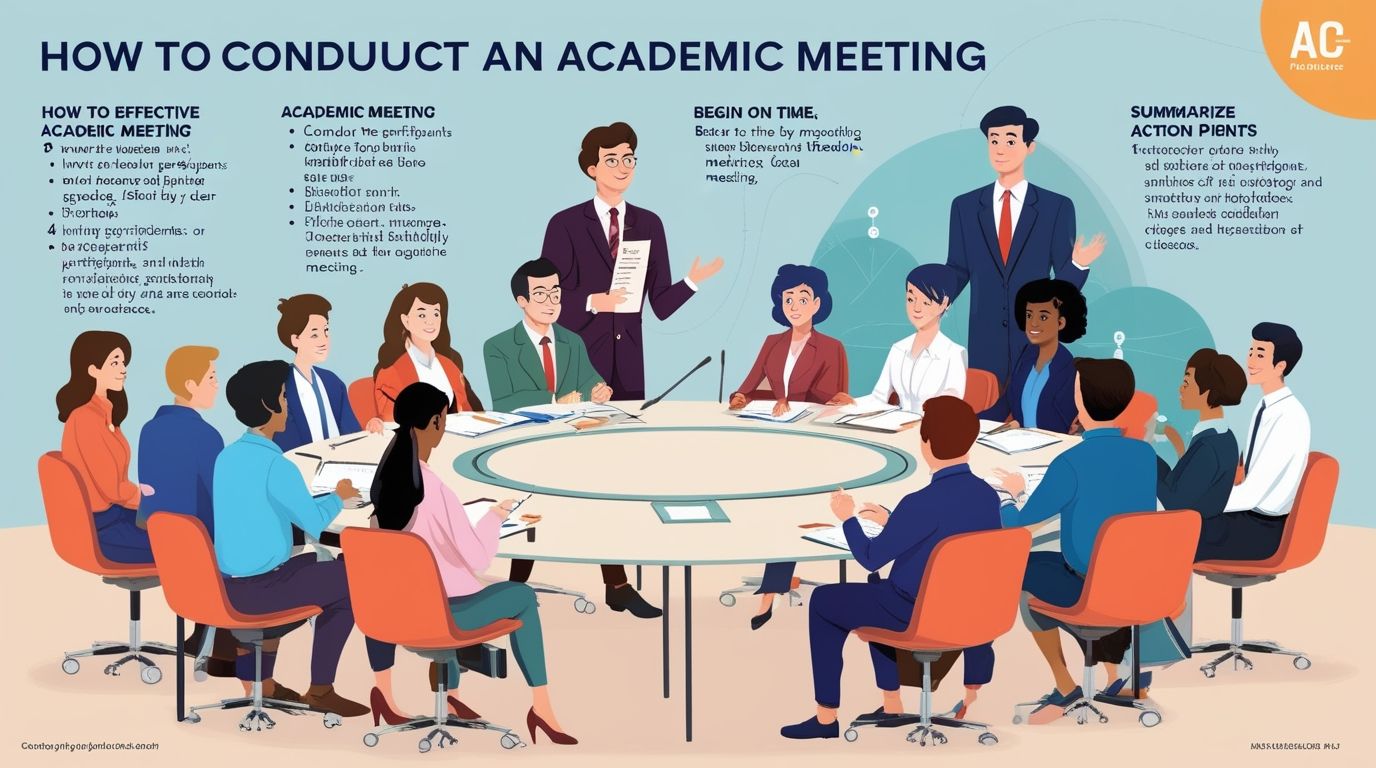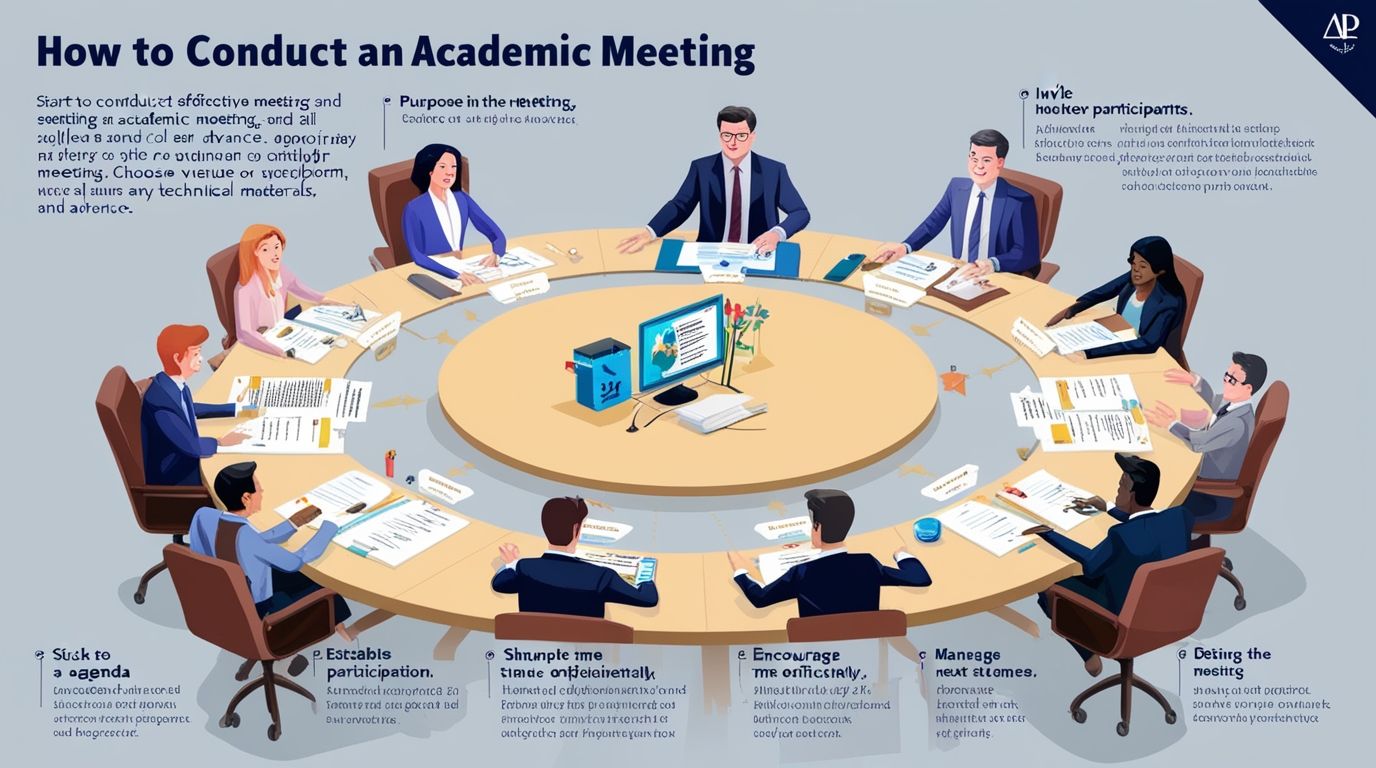Introduction
How to Conduct an Academic Meeting, Academic meetings are an essential component of academic and research institutions, providing a platform for collaboration, discussion, and decision-making. Whether it’s a faculty meeting, research group gathering, or departmental discussion, the success of an academic meeting relies heavily on effective planning, structured execution, and proper follow-up. This article provides a comprehensive guide on how to conduct an academic meeting, ensuring it is productive and meets its intended objectives.
1. Pre-Meeting Preparation
- Define the Purpose: The first step in conducting a successful academic meeting is to clearly define its purpose. Knowing the primary objective—whether it is to make decisions, share information, or brainstorm new ideas—helps in setting a focused agenda. A well-defined purpose ensures that the meeting remains relevant and that the participants understand the expected outcomes.
- Set the Agenda : A detailed agenda is the backbone of any productive meeting. It should include a list of topics to be discussed, the order in which they will be addressed, and the time allocated to each item. Distributing the agenda well in advance allows participants to prepare adequately, contributing to more informed and meaningful discussions.
- Invite the Right Participants : For an academic meeting to be effective, it is crucial to have the right people in attendance. Participants should include individuals who directly involved or have a stake in the meeting’s objectives. Overcrowding the meeting with unnecessary attendees can dilute its effectiveness, while missing critical stakeholders can lead to gaps in decision-making.
- Distribute Materials in Advance : To maximize efficiency, distribute relevant materials, such as reports, proposals, or data, before the meeting. This allows participants to review the information and come prepared with questions, comments, or insights. Pre-meeting preparation by attendees can significantly enhance the quality of discussions and decisions.
2. Meeting Setup
- Choose the Right Venue : The choice of venue can significantly impact the success of an academic meeting. Whether it’s a physical room or a virtual platform, ensure that the space is conducive to discussion and free from distractions. For virtual meetings, select a reliable platform that supports the required features such as screen sharing, breakout rooms, and chat functions.
- Technical Arrangements : Ensure that all necessary technical equipment, such as projectors, microphones, or internet connections, are functional before the meeting begins. Technical glitches can cause delays and disrupt the flow of the meeting, so having a backup plan for common issues is also advisable.
- Time Management : Academic meetings should have a clear start and end time. Respecting these times shows consideration for participants’ schedules and encourages punctuality. An overrun can lead to participants losing focus or having to leave, which can compromise the effectiveness of the meeting.

3. Conducting the Meeting
- Start on Time : Starting the meeting on time sets the tone for punctuality and respect. It demonstrates to attendees that their time valued and that the meeting is well-organized. Begin with a brief introduction that includes the meeting’s purpose and a review of the agenda.
- Introductions and Ground Rules :If participants not already acquainted, a round of introductions essential. Setting ground rules at the beginning—such as encouraging respectful communication, limiting side conversations, and designating when and how questions should be asked—helps in maintaining order throughout the meeting.
- Follow the Agenda :A structured agenda should guide the meeting, ensuring that each topic receives the appropriate amount of attention. Deviations from the agenda can be counterproductive and should minimized unless critical issues arise. Keeping the meeting focused on the agenda helps in managing time effectively.
- Facilitate Participation :An inclusive meeting encourages participation from all attendees. The meeting facilitator should actively invite input, especially from quieter members, to ensure a diversity of perspectives. This can be achieved through direct questions, small group discussions, or anonymous input methods for sensitive topics.
- Manage Time Effectively :Effective time management is crucial to cover all agenda items without rushing through important discussions. The facilitator should monitor the time and gently steer conversations back on track if they deviate or become overly lengthy. Using a timer or assigning a timekeeper can be helpful tools in this regard.
4. Managing Discussions
- Encourage Open Dialogue :Academic meetings thrive on open dialogue and the free exchange of ideas. Creating a collaborative environment where participants feel comfortable sharing their thoughts without fear of judgment is essential. Active listening and positive reinforcement can foster a more engaging discussion.
- Stay on Topic :While open dialogue is encouraged, it’s important to keep conversations aligned with the agenda. Tangential discussions can be noted for future meetings or addressed offline, ensuring that the meeting stays focused on its primary objectives.
- Handle Conflicts Diplomatically :Disagreements are a natural part of academic meetings, especially when diverse opinions are involved. The facilitator should manage conflicts diplomatically by acknowledging differing viewpoints and guiding the discussion towards a constructive resolution. Establishing a process for addressing conflicts, such as a brief cooling-off period or structured debate, can also be beneficial.
- Decision Making :Clearly outline the decision-making process at the start of the meeting. Whether decisions are made by consensus, voting, or the chair’s directive, transparency in the process helps manage expectations and ensures that outcomes are accepted by the group.
5. Closing the Meeting
- Summarize Key Points :Before concluding, summarize the main points discussed, the decisions made, and any unresolved issues. This helps reinforce the meeting’s outcomes and ensures that everyone leaves with a clear understanding of the next steps.
- Assign Action Items :Clearly define action items, assign responsibilities, and set deadlines. Documenting these assignments in real-time and displaying them to participants can help in gaining commitment and accountability.
- Set Follow-Up Plans :If necessary, schedule follow-up meetings or set check-in points to monitor progress on action items. This ensures that the meeting’s outcomes translated into tangible actions and keeps the momentum going.
- Thank Participants :Always conclude by thanking participants for their time and contributions. Acknowledging their efforts fosters a positive meeting culture and encourages engagement in future meetings.
6. Post-Meeting Actions
- Distribute Meeting Minutes :Meeting minutes serve as an official record and should be distributed promptly after the meeting. They should include key points, decisions, action items, and deadlines. Accurate and timely minutes ensure that all participants are on the same page and provide a reference for future meetings.
- Follow Up on Action Items :Regularly follow up on the progress of assigned tasks. This can be done through emails, brief check-ins, or during the next meeting. Consistent follow-up ensures accountability and that the meeting’s objectives are being met.
- Solicit Feedback :To continuously improve the effectiveness of academic meetings, solicit feedback from participants. This can be done through informal conversations, surveys, or at the end of the meeting. Constructive feedback helps identify areas for improvement and can lead to more productive future meetings.
Conclusion
Conducting a successful academic meeting involves meticulous preparation, effective management, and diligent follow-up. By clearly defining objectives, setting a structured agenda, engaging participants, and ensuring accountability, academic meetings can become valuable tools for collaboration and decision-making. Continuous improvement of meeting practices, based on feedback and reflection, can further enhance their effectiveness and contribute to the overall success of academic endeavors.

7 thoughts on “How to Conduct an Academic Meeting”
Comments are closed.